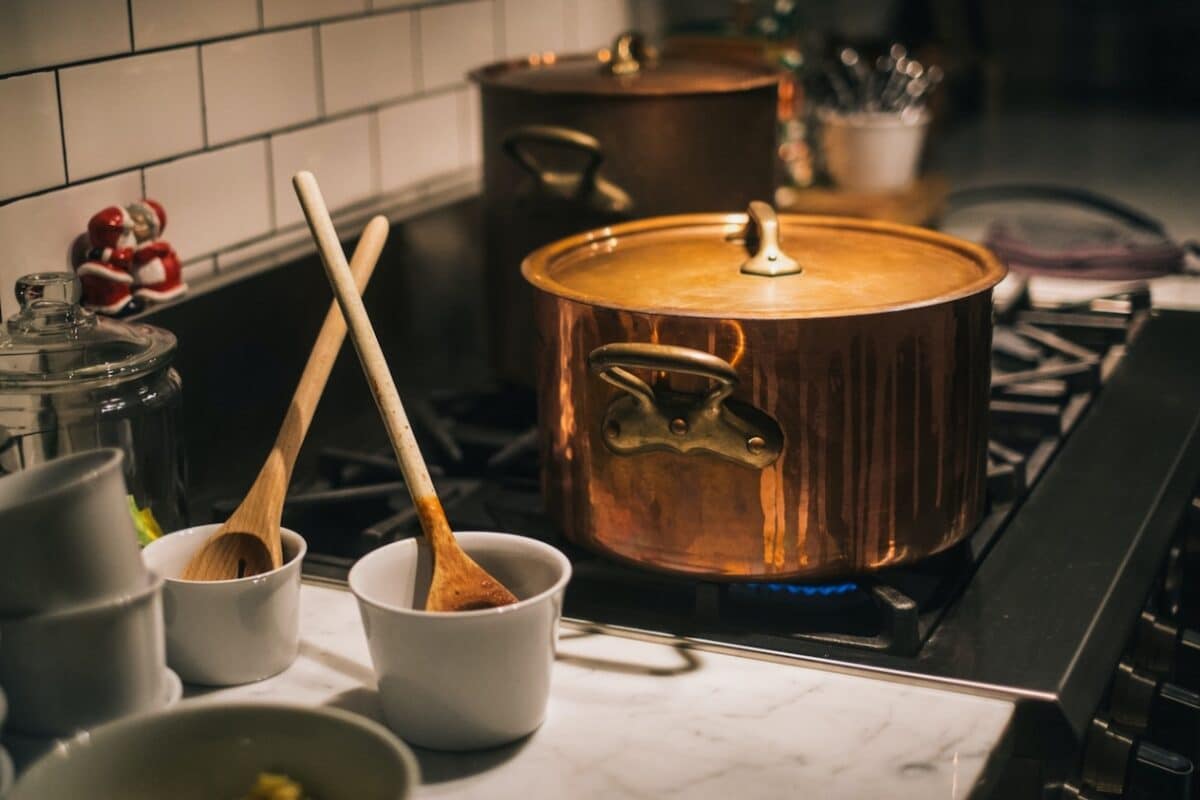

We all love convenience food, but one of the simplest ways to improve your health is by preparing more home-cooked meals. Here's how to get started.

Reviewed by Jordan Hill, MCD, RD, CSSD, a Certified Registered Dietitian at Top Nutrition Coaching working with athletes, pregnant and postpartum moms, and those with various gastrointestinal disorders and chronic diseases
Whether you live on your own or are a busy parent, finding the time and energy to prepare home-cooked meals can seem like a daunting task. At the end of a hectic day, eating out or ordering in might feel like the quickest, easiest option. But convenience and processed food can take a significant toll on your mood and health.
Convenience food is typically high in chemical additives, hormones, sugar, salt, unhealthy fat, and calories, all of which can adversely affect your brain, outlook, and physical health. It can leave you feeling tired, bloated, and irritable, and exacerbate symptoms of depression, stress, and anxiety.
Restaurants often serve portion sizes greater than the average person’s needs, sometimes as much as two to three times larger than the recommended dietary guidelines. This encourages you to eat more than you would at home, having the potential to adversely affect your waistline, blood pressure, and risk of diabetes.
When you prepare your own meals, you have more control over the ingredients. By cooking for yourself, you can ensure that you and your family eat fresh, wholesome meals. This can help you to look and feel healthier, boost your energy, stabilize your weight and mood, and improve your sleep and resilience to stress. It can also help you to save money.
Cooking at home doesn’t have to be complicated. The cornerstone of a healthy diet is to eat food that is as close as possible to the way nature made it. That means replacing processed food with whole foods whenever possible, and eating plenty of vegetables and healthy sources of protein. It doesn’t mean you have to spend hours in the kitchen combining hundreds of different ingredients or slavishly following elaborate recipes. In fact, simple meals are often the tastiest.
Cooking at home can even take less time than eating out. There are plenty of quick, simple, and wholesome meals you can cook at home in less time than it takes to travel to a restaurant or wait for a delivery.
Cooking at home is also a great way to spend time with others—and you don’t have to be an accomplished chef. Whatever your abilities or experience as a cook, you can learn to prepare quick and healthy meals that can have real benefits for your mental and physical health. Cooking with others is also a great way to spend quality time and learn new skills together.
| Benefits of cooking at home |
| Health benefits |
| Preparing healthy meals at home can support your immune system and reduce the risk of illnesses such as heart disease, cancer, high blood pressure, and diabetes. |
| It can give you more energy, improve how you sleep at night, and help you better manage health problems. |
| In women, cooking healthy food can help reduce symptoms of PMS and menopause, and boost fertility. |
| If you’re on a special diet or trying to lose weight, preparing meals for yourself gives you more control over ingredients and portion sizes, enabling you to better control your weight or cope with food allergies. |
| By practicing safe food handling while you cook at home, you’re less likely to contract a foodborne illness. |
| Cooking at home can sharpen your mind, fight cognitive decline, and decrease your risk of Alzheimer’s. |
| It can stabilize kids’ energy and help them grow into healthy, confident adults. |
| Emotional and social benefits |
| The simple process of cooking at home can be empowering and improve your mood and self-esteem. |
| Taking time out from a busy schedule to cook can also be a great stress reliever. |
| Preparing even simple meals at home can be creatively fulfilling. |
| Adopting a diet of healthy, home-cooked meals can increase your resilience to stress, anxiety, and depression and boost your mood and outlook. |
| Cooking and eating with family is a great way to bond with your loved ones. |
| Inviting friends to join you can expand your social circle, which can alleviate stress and boost morale and a feeling of connectedness. |
| Eating wholesome meals can even add joy to your life. When your body feels healthier, you feel happier—inside and out. |
Studies have also shown that when you regularly prepare home-cooked meals, you’re also more likely to make healthier choices on those occasions when you do eat out. In other words, eating healthy food can become a habit.
Food brings people together and cooking at home is a great way to unite your family over the dining table. Everyone loves a home-cooked meal—even moody teenagers or picky eaters. And if you live alone, that doesn’t mean you have to cook or eat alone. Sharing meals with others is a great way to expand your social network. Getting appreciative feedback on a meal you’ve prepared for someone can bring a real boost to your self-esteem, too.
Make mealtimes a social experience. The simple act of talking to a friend or loved one over the dinner table can play a big role in relieving stress and boosting mood. Gather the family together and stay up to date with each other’s daily lives. If you live alone, invite a friend, coworker, or neighbor over.
Switch off screens. Take a break from the TV, turn off your phone, and avoid other distractions so you have a real chance to connect with the person you’re sharing a meal with. By avoiding screens and eating with others, you’ll also help to avoid mindless overeating and potentially even enjoy your food more.
Cook with others. Invite your spouse, roommate, or a friend to share shopping and cooking responsibilities—one prepares the entrée, the other dessert, for example. Cooking with others can be a fun way to deepen relationships and splitting the costs can make it cheaper for both of you. Cooking a couple of additional servings will even leave you with leftovers for the next day.
Despite all the benefits, many of us still think of preparing meals as a chore, either something that we don’t have time for, or something that’s only suitable for experienced cooks. Maybe you’ve tried cooking before and didn’t like the end results, or maybe your kids just prefer takeout food?
Overcoming obstacles to cooking at home often starts with changing the way you view meal preparation or time spent in the kitchen. Some common reasons why we don’t cook at home, and what to do about them, include:
Sure, shopping, chopping ingredients, cooking, and then cleaning up afterwards can be time-consuming. But there are plenty of ways to speed things up:
At first glance, it may seem that eating at a fast food restaurant is less expensive than making a home-cooked meal. But that’s rarely the case. A study from the University of Washington School of Public Health revealed that people who cook at home tend to have healthier overall diets without higher food expenses. Another study found that frequent home cooks spent about $60 per month less on food than those who ate out more often.
With the potential benefits that cooking at home can have on your health, cutting down on junk food may help reduce future medical and drug bills, saving you more money in the long run.
Creating healthy meals doesn’t have to involve a huge investment of effort.
If you’re intimidated by the prospect of preparing a home-cooked meal, it’s important to remember that cooking is not an exact science.
Over time, you can wean your family (and yourself) off the taste of takeout and packaged food.
BetterHelp is an online therapy service that matches you to licensed, accredited therapists who can help with depression, anxiety, relationships, and more. Take the assessment and get matched with a therapist in as little as 48 hours.
Take Assessment HelpGuide is user supported. We earn a commission if you sign up for BetterHelp’s services after clicking through from this site. Learn moreDon’t think that you have to make every meal at home. Cooking at home just a few times a week to begin with can reap rewards. The more you prepare your own meals, the better you’ll get at it. Eventually, you may find that eating out or ordering in becomes an occasional treat rather than the norm. Here are some tips to get you started:
Start with fresh, healthy ingredients. Baking sugary snacks such as brownies, cakes, and cookies is fine from time to time, but probably best viewed as an occasional treat since they don’t provide much nutritional value. Similarly, adding too much sugar or salt can transform a healthy home-cooked meal into an unhealthy one. To ensure your meals are good for you as well as being tasty, start with healthy ingredients and flavor with spices rather than sugar or salt.
Keep it simple. Steam or sauté some veggies, grill some fish or chicken, add some herbs, spices, or a healthy sauce. Simple cooking can be tasty and quick.
Cook enough for leftovers. It’s great to have leftovers that can be used for a quick and easy lunch or dinner the next day. When making things like rice or pasta, cook at least double the amount you need and store it in the fridge to use with other meals. Freezing leftovers can also ensure you have a home-cooked meal on hand whenever you don’t have the time or don’t feel like cooking.
Make substitutions for healthier meals. Grill or bake instead of fry. Replace salt with garlic or onion powder. Cut the sugar called for in most recipes by 1/3 to 1/2 or use a natural sugar alternative like Stevia. Increase the lean meat and vegetables in stews and casseroles. Choose whole-grain versions of pasta and bread, and substitute whole-wheat flour for bleached white flour when you bake for more fiber intake.
Stock up on staples. Ingredients such as rice, pasta, olive oil, spices, flour, and stock cubes are staples you’ll likely use regularly. Keeping cans of tuna, beans, tomatoes and bags of frozen veggies on hand can be helpful in rustling up quick meals when you’re pushed for time.
Give yourself some leeway. It’s okay to burn the rice or overcook the veggies. After a few tries it will get easier, quicker, and tastier!
Last updated or reviewed on February 5, 2024Millions of readers rely on HelpGuide.org for free, evidence-based resources to understand and navigate mental health challenges. Please donate today to help us save, support, and change lives.
Donate to HelpGuide.org today